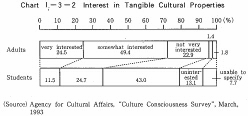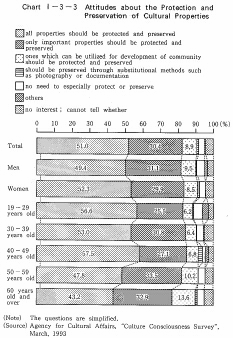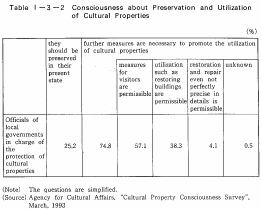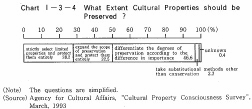| Home > Policy > White Paper, Notice, Announcement > White Paper > JAPANESE GOVERNMENT POLICIES IN EDUCATION, SCIENCE AND CULTURE 1993 > CHAPTER 3 �1 2 (1) | ||
According to the "Culture Consciousness Survey", adults expressed keen interest in tangible cultural properties such as prehistoric tombs, old shrines, temples, historic villages and towns, with half of them replying "somewhat interested", and one quarter replying "very interested". In contrast to this, more than half of the students surveyed answered that they were "not very interested" (about 40%) or "uninterested" (Chart l-3-2). As to interest in intangible cultural properties such as folk performing arts and festivals, over 60 % of the adults expressed interest, but this figure is lower than that for tangible cultural properties. A similar tendency was observed in the students' answers.

Concerning attitudes about the protection and preservation of cultural properties, the majority of the adults maintained that cultural properties should be protected, with more than half answering that "all properties should be protected and preserved", and 30% answering that "only important properties should be protected and preserved". Women tend to favor a greater degree of protection than men, and younger people tend to favor a greater degree of protection than their elders (Chart I-3-3). Geographically, the number of people favoring a high degree of protection for cultural properties was somewhat less in smaller cities, which may indicate that those residing in smaller cities desire community development as well as protection of cultural properties. In February 1993, the Agency for Cultural Affairs commissioned a private research institution to carry out a "Survey of Consciousness Regarding Cultural Properties Administration" (hereafter referred to as the "Cultural Property Consciousness Survey"), in which inquiries were made to local government officials in charge of protecting cultural properties. According to the results of the survey, the number answering "further measures are necessary to promote the utilization of cultural properties" was three times greater than those who responded "they should be preserved in their present state". The majority, however, expressed the need for care during the utilization of cultural properties with only a few of the respondents favoring repair and restoration of cultural properties, even if the work done was somewhat lacking in precision (Table I- 3 2). Concerning the score of protection of cultural properties, little support was found for preservation through substitutional methods such as photography or documentation. There are then, different opinions as to the extent to which cultural properties should be preserved, but this matter will remain a tonic for future consideration (Chart I -3-4).



| Back to Top | MEXT HOME |